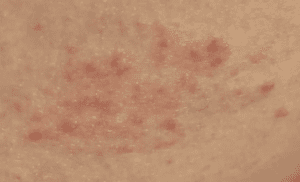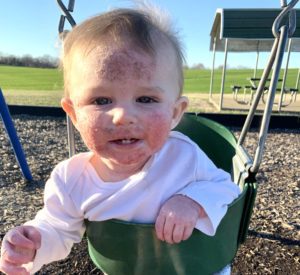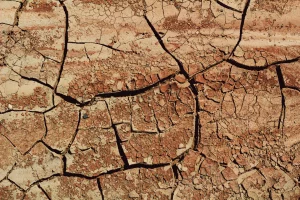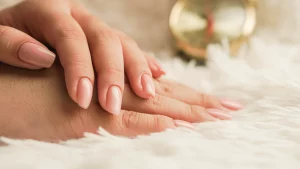WHAT DOES ECZEMA LOOK LIKE?
Eczema is a really common condition nowadays and it can be incredibly uncomfortable affecting one’s quality of life.
This chronic inflammatory skin condition, also known as dermatitis, it’s a bit of a mystery. There are many studies being done to try to find out the core cause of it. Yet it is still unknown.
We know environmental conditions, stress, and allergens will cause an overreaction on the immune system. This results in the skin flaring up. Many internal and external factors can trigger dermatitis. And if left untreated things can escalate pretty quickly.
Therefore it’s important to understand our bodies and identify what are those triggers for us so we can avoid any flares from making any appearances at all.
The most common type of eczema is atopic dermatitis. However, there are many different types of dermatitis with different signs and symptoms. The triggers can be different for each of them. So let’s look at the most common and frequent ones.
Hallmark signs and symptoms
It’s important to understand that eczema will show up differently for each person, different skin types will react differently. Also, the severity of the flare-up will be a big factor in how dermatitis shows up.
Nonetheless, there are some general signs and symptoms to keep in check. They will give us the first indication that we are dealing with eczema and not something else.
These general signs and symptoms are:
- Blisters
- Swelling
- intense itch
- Cracks in skin
- Rough patches
- Skin discoloration
- Dry flaky sensitive
- Fluid discharge from affected areas
Some people might experience one or two at a time. However, it’s not uncommon to experience all of them at the same time or even different ones at different times.
It will depend on a few different factors. If you’re prone to dry skin it will show up differently than if you are not. Also, the severity of the flare-up, the area on the body that’s being affected, the weather, and stress levels are also factors to consider.

We can have a better understanding, therefore better manage these flare-ups when we can recognize the signs and symptoms that show up for us. Being able to manage eczema when it’s starting to show up, is key to not letting it get out of control!
Eczema and self-diagnosis
We all know skin is incredibly unique. So before we go any deeper into exploring what eczema looks like, it’s important to note that a proper diagnosis from a doctor or health practitioner is key in treating and managing eczema.
Since eczema can show up very differently and the skin can react in similar ways to other stressors you might think you are experiencing some sort of dermatitis. When it could be you’re dealing with a heat rash, food poisoning, an allergic reaction, or something else.
So, the diagnosis from a doctor or health practitioner will pinpoint exactly what you are dealing with. You will be able to find the culprit which might be something you can simply eliminate and be done with it.
And it’s important that you discuss how this condition is affecting you in any other aspects of life. Together, you can come up with the management plan that best suits you, your lifestyle, and your unique skin needs.
Eczema: how it looks and feels to the touch
One of the first signs of eczema is dry itchy skin. The itching is usually pretty intense and uncomfortable, to the point that it’s hard to focus on something else.
And usually, these patches will appear where your skin “bends”. For example, the back of your knees and elbow, between your fingers, the neck, or your eyelids.
These areas are really sensitive and after they can become inflamed and irritated pretty easily. With eczema, the patches are usually rough to the touch or even scaly. Some people describe it as a leathery feel. There are dermatitis types where the flare shows up as small bumps or blisters, as well.
Another sign to look for is if your skin feels warm to the touch. Also, swollen skin or a constant burning or stinging are common signs of eczema.
Eczema on the face
Eczema can show up anywhere and everywhere. It is not uncommon to see the skin on the face flaring up, which can be quite distressing.
First, because it’s so visible it really affects one’s self-confidence. Also, the face is an area of our body that is always exposed to the sun, weather, pollutants, etc. Which can make it harder to ease the symptoms and keep the skin protected.

Facial skin is already very sensitive, so any inflammation can turn into a rather uncomfortable episode. In areas such as the eyelids or the under eyes, the skin might break easily, look wrinkled and in the long run, the skin might look bruised.
We can identify eczema on the face when the skin looks red, inflamed, irritated, or scaly. Most people present patches, however, large areas of the face might be affected as well. Also, feeling pain or the characteristic uncontrollable itch will be present.
Eczema on the hands
Another common place where eczema likes to show up is on the hands. Similar to the face, our hands are constantly exposed and touching things. It mainly appears on the palm of the hands, or between the fingers however, the whole hand can flare-up.
Depending on the type of dermatitis and the severity of the episode you might experience different things. The hands can become really dry and painful. In this instance, moisturizers don’t quite do the trick, which results in scaly or cracked skin that becomes rough to the touch.
There are also certain types of hand dermatitis that show up as small watery blisters that are very itchy. These will eventually dry and turn into a scaly patch of skin. In both cases, the itch and inflammation will be present.
What does eczema look like in children?
Dermatitis is a common condition in children and it often appears before the first year of age. It’s important to identify what your child is dealing with early on so you are able to better manage it and eliminate whatever triggers their eczema as much as possible.
Signs and symptoms in children tend to change drastically as they get older. Eczema will look significantly different for an infant, a baby, a toddler, and older kids.
Infants
For infants, eczema usually develops on the face, mainly the cheeks, chin, forehead, and scalp.
At this stage the skin shows red patches that are also inflamed and bumpy, it looks somewhat like a rash. Sometimes infants will develop eczema in the nappy area as well, however, the face is the most common.
Babies
After about 6 months of age, the dermatitis transfers to the elbows and knees, or places where the baby can easily scratch and rub. Added to the red patches, skin becomes a bit crusty and is prone to infection.
Toddlers & older children
In toddlers and older children, eczema develops in the back of the knees and elbows, wrists, hands, neck, and eyelids. And in some cases, it affects the whole body. The skin looks dry and scaly and begins to thicken and feel leathery due to the constant scratching.

Eczema is a complex condition. Therefore understanding what it looks like, what we need to be concerned about, and when we should see a professional will make a big difference in how we or our loved ones experience the effects of this condition.








0 Comments